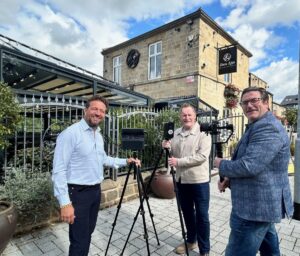How Customised Rugged Devices Deliver a Strategic Advantage

Professionals working in industries such as utilities, manufacturing, transport and logistics, law enforcement and defence operate in some of the most demanding and unpredictable conditions. From extreme weather and potentially hazardous scenarios to remote locations, these environments can push digital equipment to its limits. Yet many organisations still rely on commercial off-the-shelf (COTS) devices, which are rarely built for such pressures.
The rise of digital transformation and AI-driven operations is only increasing the need for robust, reliable mobile computing. However, procurement strategies often lag behind, prioritising general-purpose IT over fit-for-purpose rugged solutions. IDC forecasts device spending will top $1.04 trillion in 2024, yet hardware only comprises 17% of IT budgets, highlighting a disconnect between infrastructure needs and spending priorities.
Customisation as a Strategic Lever
In high-stakes environments, a “one-size-fits-all” approach rarely suffices. Organisations need devices that align not only with physical conditions but also with operational workflows, regulatory compliance, and long-term goals. That’s where rugged device customisation, such as that offered by Getac, becomes a strategic advantage.
For Getac, true customisation goes beyond branding or minor hardware tweaks. It means tailoring the device to the specific environment and use case, whether that’s extreme temperatures, sensitive data workflows, or compliance with industry regulations. Done properly, customisation delivers:
- Higher uptime and reliability
- Faster deployment (e.g., pre-loaded software or SIM cards)
- Better user adoption
- Lower total cost of ownership
- Greater compliance and safety assurance
Indeed, rugged computers already deliver a 38.7% lower total cost of ownership over five years compared to consumer-grade devices. Add in thoughtful customisation, and these systems become integral tools for field productivity and operational resilience.
A Strategic Customisation Process
The process of building customised rugged solutions starts with understanding the specific use case for each device. Engineers and designers must work closely with end users to identify environmental demands, workflow challenges, and compliance requirements. This may involve designing features like tamper-proof enclosures, tailored utility report formats, or support for legacy systems.
Rugged devices are also tested vigorously to comply with the MIL-STD-810H standard. This battery of tests simulates real-world conditions, which include exposure to extreme temperatures, drop tests, vibration tests, and assessments of water resistance. MIL-STD-810H certification supports strong in-field performance, helping to minimise disruptions and enhance user confidence during operations.
Long-term success also hinges on ongoing support. From software updates to hardware upgrades and security patches, the ability to evolve alongside changing business needs ensures these devices remain an asset rather than a liability.
Innovation in Practice
Custom rugged solutions often integrate the latest innovations to keep pace with industry demands, including:
- AI-ready processing for advanced analytics
- Seamless connectivity in remote areas
- Bright and durable touchscreens operable with gloves or in rain
- Enhanced security features at BIOS and OS levels
Real-World Impact Across Sectors
Getac’s customised rugged devices with industry-specific components have already proven transformative across various industries. Below are some examples of this:
- Utilities: Field technicians benefit from SubMiniature version A (SMA) connectors that enhance antenna signals in underground environments, increasing both safety and productivity.
- Law Enforcement: Custom rugged laptops are designed with secure doors and flexible I/O port control for reliable, encrypted data access in mobile units.
- Automotive Diagnostics: Diagnostic laptops can be fitted with custom rugged USB ports designed to withstand repeated connections to on-board diagnostics (OBD) scan tools and other vehicle communication interfaces, significantly reducing failure rates and downtime. This enhancement ensures reliable performance and helps prevent data transfer issues during critical tasks like engine control unit (ECU) re-flashing, where any interruption could require costly replacements.
- Military and Defence: Basic Input/Output System (BIOS)-level security, modular configurations, and MIL-STD compliance help ensure mission-critical reliability. Some customers also require the complete removal of all communications modules from a device, such as Wi-Fi, Bluetooth, and GPS, so they can be used in secure defence environments where data isolation is critical.
These enhancements don’t just minimise repair and replacement costs, they increase field efficiency and reduce the hidden costs of downtime and support.
Collaboration Over Transaction
What differentiates successful rugged solution providers like Getac is not just their technology but their approach. Effective partnerships require consultative collaboration from the initial discovery and prototyping to deployment and post-sales support. Understanding real-world use cases and designing to fit them is key.
Scalability also matters. Whether supporting enterprise-wide rollouts or niche departmental needs, the ability to deliver quickly, at scale, and with precision is a clear competitive edge. Even small or mid-sized organisations can benefit through modular design options such as glove-compatible touchscreens, integrated scanners, or legacy port support.
Purpose-Built Technology for Demanding Work
In today’s always-on landscape, performance and reliability are non-negotiable. Harsh conditions, evolving tech stacks, and tighter regulations demand more than general-purpose devices can offer. By investing in rugged solutions that are custom-built for their specific use case, organisations gain not just resilience, but a strategic advantage. These tools empower field teams, improve data integrity, enhance compliance, and ultimately help companies do more with less risk.





